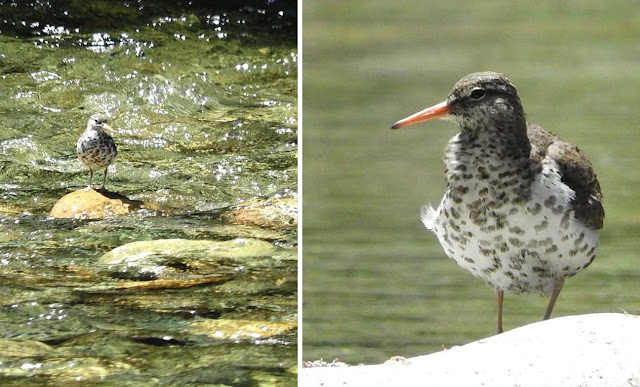Common Merganser (female) with 8 chicks - Mergus merganser
We have company this week, so I don't have time to write a lengthy blog. I did want to share these photos of Common Mergansers that I was incredibly lucky to see this week. I was on the bridge over the North Yuba River one morning, and saw a distant white object on the river. I zoomed in with my camera and realized it was a female Merganser. Then I noticed some little birds moving around as well. They were her 9 babies! Wow! As I watched, they cruised up-river along the shoreline in my direction. Within minutes they were underneath the bridge right where I was! What a delight it was to watch these beautiful ducklings and their mother on the clear water of the No.Yuba River!
Common Merganser ducklings - Mergus merganser
American Dipper - Cinclus americanus
That same morning I also saw an American Dipper and a pair of Spotted Sandpipers! How fun! I'll write about them next week!
Spotted Sandpiper - Actitis macularia
White Rein Orchid - Spotted Coral Root - Green Rein Orchid
Plantathera leucostachys - Corallorhiza maculata - Plantathera sparsiflora
Wild Orchids!
There are 8 species of orchids listed in John Muir Laws' book, Laws Field Guide to the Sierra Nevada. I have seen 6 of them so far. They grow in both low and high elevations. Most of them grow in wet areas, but some grow in the dry forest floor. The Spotted Coral Root (above, center) does not photosynthesize and depends upon the mycorrhizal fungus in soil for its nutrients. Each orchid has a specific insect pollinator, usually a fly, bee, or moth, that is attracted to its scent!

Giant Stream Orchid - Epipactis gigantea
The Giant Stream Orchids pictured above grow along Highway 49, a few miles past Downieville. They have formed several colonies of hundreds of orchids in this one section of the highway! They reproduce through rhizomes and seeds. They are not usually noticed by motorists, as their coloring is a overall greenish brown. However, upon close inspection they're gorgeous! They are blooming right now so stop and take a look, but please don't pick the orchids!
Clockwise from top left:
Black-headed Grosbeak (Pheucticus melanocephalus )
American Robin (Turdus migratorious) - Western Gray Squirrel (Sciurus giseus)
Band-tailed Pigeon (Columba fasciata)
Cherry Festival Ends!
The wild domestic cherries in our neighborhood are almost all gone! They've been eaten by the local critters pictured above as well as bear, fox, raccoons, and chickarees! Once the cherries are ripe, the bird population seems to increase 10 fold! Band-tailed Pigeons can de-cherry a tree in a day! It's been quite a commotion in the trees, with birds flying back and forth looking for the last cherry in the neighborhood! Gray Foxes can also climb trees! I've seen cherry pits in their scat, but there are also lots of edible cherries on the ground. I've never seen a Gray Fox up in a tree, but my neighbor has! Wouldn't that be marvelous to see!
Bullock's Orioles (male & female) - Icterus bullockii
Bullock Tales!
This week it has been fascinating to watch the female Bullock's Oriole that I thought was recycling nesting material. It turns out that she wasn't recycling, she was building a new nest in the same tree she built a nest in last year! We also thought that there were two females building it, but it's a "first year" male and a female!!! First year males don't have the brilliant orange/red heads that mature males have. They are mostly all yellow like the females, but they have a black stripe on their throat (above, bottom left). We watched the male follow the female as she flew around gathering nesting material. We also saw him puff up and perform a mating display (above, middle left)! We watched them for several days, fly in and out of the tree where the new nest is. Then, two days ago, another male showed up and dove at the "first year" male! Right after that, they stopped building their nest! We didn't see them at all for the next few days! However, my neighbor said that there were two "female" Bullock's Orioles pulling nesting material out of an old stuffed toy in her backyard! I'll bet it's the "first year" male and the female that we have been watching! That's exciting!!! I'll check them out this week!
Drummond's Anemone - Anemone drummondii
Were you able to identify those two blue flowers I posted last week?
They are Drummond's Anemones. We came across them around 6,500' in elevation off the Mt. Elwell trail. We first came across them three years ago in the Spring. Even though they aren't listed as rare, I have never seen them before, and I've hiked in the Sierras for 30+ years! What an exciting find!
What kind of spider is this?
Where are the reptiles and amphibians?
Where are the bear and the deer?
What kind of insect is this?
Check back next week for the answers to these questions and more!
If all of a sudden you haven't been getting email notices of my blog being published, just sign up again on my blog. I don't know why you got "unsubscribed". It's some kind of problem with Blogspot.com and/or Feedburner.com. I apologize for this glitch!
Your questions and comments are greatly appreciated!
Please email me at northyubanaturalist@gmail.com










No comments:
Post a Comment